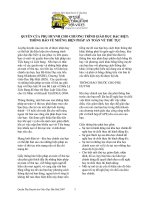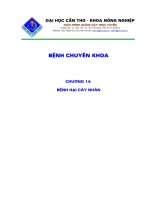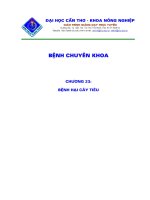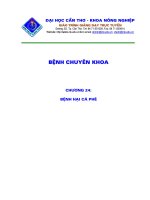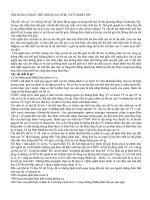Tài liệu Specialty Optical Fibers Handbook docx
Bạn đang xem bản rút gọn của tài liệu. Xem và tải ngay bản đầy đủ của tài liệu tại đây (9.75 MB, 841 trang )
Specialty Optical Fibers Handbook
Mendez / Specialty Optical Fibers Handbook prelims Final Proof page i 31.10.2006 9:35pm
This page intentionally left blank
Specialty Optical Fibers
Handbook
ALEXIS ME
´
NDEZ
MCH Engineering, LLC, Alameda, California
T. F. MORSE
Photonics Center, Boston University, Boston, Massachusetts
AMSTERDAM • BOSTON • HEIDELBERG • LONDON
NEW YORK • OXFORD • PARIS • SAN DIEGO
SAN FRANCISCO • SINGAPORE • SYDNEY • TOKYO
Academic Press is an imprint of Elsevier
Mendez / Specialty Optical Fibers Handbook prelims Final Proof page iii 31.10.2006 9:35pm
Academic Press in an imprint of Elsevier
30 Corporate Drive, Suite 400, Burlington, MA 01803, USA
525 B Street, Suite 1900, San Diego, California 92101-4495, USA
84 Theobald’s Road, London WCIX 8RR, UK
This book is printed on acid-free paper.
Copyright ß 2007, Elsevier Inc. All rights reserved.
No part of this publication may be reproduced or transmitted in any form or by any means, electronic
or mechanical, including photocopy, recording, or any information storage and retrieval system,
without permission in writing from the publisher.
Permissions may be sought directly from Elsevier’s Science & Technology Rights Department in
Oxford, UK: phone: (+44) 1865 843830, fax: (+44) 1865 853333, E-mail:
You may also complete your request on-line via the Elsevier homepage (), by
selecting ‘‘Customer Support’’ and then ‘‘Obtaining Permissions.’’
Library of Congress Cataloging-in Publication Data
Application Submitted
British Library Cataloguing in Publication Data
A catalogue record for this book is available from the British Library
ISBN 13: 978-0-12-369406-5
ISBN 10: 0-12-369406-X
For information on all Elsevier Academic Press publications
visit our Web site at www.books.elsevier.com
Printed in the United States of America
0607080910 987654321
Mendez / Specialty Optical Fibers Handbook prelims Final Proof page iv 31.10.2006 9:35pm
To my wife Shiva
for her unconditional love, support, and patience
A.M.
‘‘Under the shade of your tresses,
how softly slept my heart,
intoxicated and lovely,
so peaceful and so free ’’
RUMI
To Edelgard
for her patience, wisdom, and love.
T.F.M.
Mendez / Specialty Optical Fibers Handbook prelims Final Proof page v 31.10.2006 9:35pm
This page intentionally left blank
Contents
Dedication v
Editors xxiii
List of Contributors xxv
Preface xxxvii
1 Specialty Optical Fiber Market Overview 1
Stephen Montgomery
1.1 Market Overview 1
1.1.1 Production Versus Consumption 1
1.1.2 Rapidly Growing Need to Use Fiber Optic Sensors 2
1.1.3 Weapon System Development 3
1.1.4 100–1000Â Improvements in Performance 3
1.1.5 High Cost of Functionality 4
1.1.6 Multiple Features in the Same Specialty Fibers 4
1.2 Specialty Optical Fibers: A Few Selected Examples 4
1.2.1 Fluoride Fiber 4
1.2.2 Tellurite Fiber 5
1.2.3 Bismuth-Doped Fiber 5
1.2.4 Polarizing Fiber 6
1.2.5 Photonic Crystal Fiber—Holey Fibers 7
1.2.6 Dispersion-Compensating Fiber 8
1.2.7 High-Index Fiber 11
1.2.8 Polarization-Maintaining Fiber 11
1.2.9 Photosensitive Fiber 13
1.2.10 Erbium-Doped Fiber 13
1.3 Conclusions 17
2 Light-Guiding Fundamentals and Fiber Design 19
Robert Lingle, Jr., David W. Peckham, Alan McCurdy,
and Jinkee Kim
2.1 Introduction 19
2.2 Physical Structure of a Telecommunications Optical Fiber 20
Mendez / Specialty Optical Fibers Handbook prelims Final Proof page vii 31.10.2006 9:35pm
vii
2.3 Linear Lightwave Propagation in an Optical Fiber 20
2.3.1 Electromagnetic Preliminaries 20
2.3.2 Intuition from the Slab Waveguide 22
2.3.3 Optical Fiber: A Cylindrical Waveguide 24
2.3.4 The Linearly Polarized Mode Set LP
lm
25
2.3.5 Finite Element Analysis for Waveguide Calculations 27
2.4 Working Definitions of Cutoff Wavelength 29
2.4.1 Introduction 29
2.4.2 Theoretical Cutoff Wavelength 29
2.4.3 Effective Cutoff Wavelengths 29
2.5 Impact of Profile Design on Macrobending Losses 32
2.5.1 The Depressed Cladding Fiber Design 32
2.5.2 Phenomenology of Macrobending Loss 34
2.6 Fiber Attenuation Loss 36
2.7 Origins of Chromatic Dispersion 38
2.7.1 Introduction 38
2.7.2 Material Dispersion 38
2.7.3 Waveguide Dispersion 42
2.8 Polarization Mode Dispersion 45
2.8.1 Overview 45
2.8.2 Background 46
2.8.3 Modeling and Simulation 48
2.8.4 Control of PMD in Fiber Manufacturing 49
2.8.5 Measurement of PMD 51
2.8.6 Fiber-to-Cable-to-Field PMD Mapping 53
2.9 Microbending Loss 55
2.9.1 Microbending 55
2.10 Fiber Nonlinearities 60
2.10.1 Overview 60
2.10.2 Background 61
References 65
3 Overview of Materials and Fabrication Technologies 69
John B. MacChesney, Ryan Bise, and Alexis Me
´
ndez
3.1 Double-Crucible Technique 69
3.2 Vapor-Deposition Techniques 70
3.3 Outside Vapor Deposition 71
3.4 Vertical Axial Deposition 73
3.5 Direct Nanoparticle Deposition 75
Mendez / Specialty Optical Fibers Handbook prelims Final Proof page viii 31.10.2006 9:35pm
viii Contents
3.6 Modified Chemical Vapor Deposition 77
3.6.1 Chemical Equilibria: Dopant Incorporation 78
3.6.2 Purification from Hydroxyl Contamination 80
3.6.3 Thermophoresis 80
3.7 Plasma Chemical Vapor Deposition 82
3.8 Sol-Gel Processes 83
3.8.1 Alkoxide Sol-Gel Processing 83
3.8.2 Colloidal Sol-Gel Processing 84
3.9 Sol-Gel Microstructure Fiber Fabrication 86
3.10 Fiber Drawing 88
Acknowledgments 91
References 91
4 Optical Fiber Coatings 95
Steven R. Schmid and Anthony F. Toussaint
4.1 Introduction 95
4.2 Early History of Coatings for Optical Fiber 96
4.3 Evolution of Optical Fibers and Protective Coatings 97
4.3.1 Coating Contributions to Microbending
Minimization 97
4.3.2 Glass Fiber Fracture Mechanics and Coating
Contributions to Fiber Strength Retention 99
4.3.3 Durability of Fiber Optic Coatings 100
4.4 Cabling of Optical Fibers 102
4.5 Specialty Coatings 103
4.6 Basics of Optical Fiber Chemistry 103
4.6.1 Oligomers 103
4.6.2 Monomers 105
4.6.3 Photoinitiators 105
4.6.4 Adhesion Promoters 105
4.6.5 Other Additives 106
4.7 Application of Coatings on the Draw Tower 108
4.7.1 Coating Cure Speed Measurement Techniques 110
4.7.2 Cured Properties of Coatings on Fiber 113
4.7.3 Test Methods for UV-Curable Liquids
and UV-Cured Films 115
4.7.4 Coating Adhesion 117
4.8 Summary 117
Acknowledgments 118
References 118
Mendez / Specialty Optical Fibers Handbook prelims Final Proof page ix 31.10.2006 9:35pm
Contents ix
5 Single-Mode Fibers for Communications 123
Robert Lingle, Jr., David W. Peckham, Kai H. Chang,
and Alan McCurdy
5.1 Introduction 123
5.2 System Impairments Influencing Fiber Design 124
5.2.1 Limitations from Optical Signal-to-Noise Ratio 124
5.2.2 Limitations from Intersymbol Interference 125
5.2.3 Limitations from Nonlinearity 126
5.2.4 Limitations from Amplifier Technology 127
5.2.5 Can Fiber Design Be Used to Optimize
a Transmission System? 127
5.3 Overview of ITU Standards Fiber Categories 129
5.4 Optical Fibers for Reduced Attenuation 132
5.4.1 Pure Silica Core Fiber 133
5.4.2 Zero Water Peak Fiber 133
5.5 Optical Fiber Design Principles for Wideband
and High Bit Rate Transmission 141
5.5.1 Precise Dispersion Compensation 142
5.5.2 Dispersion Compensation Fiber Technology 142
5.5.3 Full-Band Dispersion Compensation 143
5.5.4 Requirement for Low Residual Dispersion 144
5.5.5 Factors Affecting Nonlinearity 145
5.5.6 Impairments Affecting Raman Amplification 147
5.5.7 Systems Implications of Tx Fiber PMD 147
5.5.8 Summary of Design Principles 148
5.6 Design of Nonzero Dispersion Fibers 148
5.6.1 Fiber Transmission Parameter Tradeoffs 149
5.6.2 Realizability, Manufacturability, and Scalability 150
5.6.3 Low-Dispersion NZDFs 152
5.6.4 Medium-Dispersion NZDFs 155
5.7 A New Paradigm in Transmission Line Design 158
References 159
6 Specialty Single-Mode Fibers 165
Lars-Erik Nilsson, A
˚
sa Claesson, Walter Margulis,
and Pierre-Yves Fonjallaz
6.1 Introduction 165
6.2 Macrohole Fiber 166
6.2.1 Microfluidic Devices 168
Mendez / Specialty Optical Fibers Handbook prelims Final Proof page x 31.10.2006 9:35pm
x Contents
6.3 Fibers with Internal Electrodes 169
6.3.1 Electrodes 170
6.3.2 Applications 173
6.4 Multicore Fibers and Components 175
6.4.1 Coupled Cores 176
6.4.2 Uncoupled Cores 180
6.4.3 Manufacturing Multicore Fibers 182
6.5 Fibers for High-Temperature–Resistant Gratings 185
6.6 Summary 188
References 188
7 Rare Earth-Doped Fibers 195
David J. DiGiovanni, Roman Shubochkin, T. F. Morse,
and Borut Lenardic
7.1 Introduction 195
7.2 Motivation 196
7.3 Host Glasses for Rare Earth Ions 198
7.4 Fabrication of Rare Earth-Doped Fibers 200
7.4.1 Overview of Optical Fiber Fabrication 200
7.4.2 Incorporation of Rare Earth Elements 202
7.4.3 Summary of Rare Earth-Doped
Fabrication Techniques 210
7.5 Erbium-Doped Fiber 210
7.5.1 Principles of Operation 211
7.5.2 Fiber Design Issues 213
7.5.3 Fiber Composition Issues 216
7.5.4 Short Wavelength Amplifiers 219
7.6 The Co-Doped Er/Yb System 222
7.7 Double-Clad Fiber 223
7.7.1 Limitations of Fiber Lasers 226
7.7.2 Methods to Improve Performance 227
7.8 Conclusion 237
References 237
8 Polarization Maintaining Fibers 243
Chris Emslie
8.1 What is a Polarization Maintaining Fiber? 243
8.2 Why Use PM Fibers?—Applications 244
8.2.1 Interferometry 244
8.2.2 The Fiber Optic Gyroscope 245
Mendez / Specialty Optical Fibers Handbook prelims Final Proof page xi 31.10.2006 9:35pm
Contents xi
8.2.3 Coherent Communications 245
8.2.4 Integrated Optics 246
8.2.5 Laser Doppler Anemometry and Velocimetry 247
8.2.6 EDFA Pump Combiners, Reflection-Suppression
Schemes, Current Sensing, and Optical Coherence
Tomography 249
8.3 How Do PM Fibers Work? 249
8.4 PM Fiber Types: Stress and Form Birefringent 250
8.4.1 Stress-Birefringent Fibers: Bowtie, PANDA,
and Elliptical Jacket 250
8.4.2 Elliptical Core, Form-Birefringent Fiber 253
8.4.3 Microstructure (‘‘Holey’’) Fibers 254
8.4.4 Polarizing Fiber 254
8.5 PM Fiber Fabrication Methods 256
8.5.1 Bowtie Fibers 256
8.5.2 PANDA Fiber 258
8.5.3 Elliptical Jacket Fiber 258
8.5.4 Elliptical Core, Form-Birefringent Fiber 260
8.5.5 Microstructure (‘‘Holey’’) Fibers 261
8.6 Key Performance Parameters 262
8.6.1 Attenuation (a) 262
8.6.2 Numerical Aperture (NA) 263
8.6.3 Is There a Connection Between Polarization
Maintenance and Attenuation? 264
8.6.4 Cutoff Wavelength (l
c
) 264
8.6.5 Mode-Field Diameter (MFD) 265
8.6.6 Beat Length (L
p
) 267
8.6.7 Extinction Ratio (ER) 269
8.6.8 H-Parameter 270
8.6.9 Effect of Test Conditions and Environment
on Polarization Maintaining Performance 270
8.7 Mechanical and Lifetime Properties 273
8.7.1 Strength Paradox I: Fragile Preforms Make
Exceptionally Strong Fibers 273
8.7.2 Strength Paradox II: Thin Fibers Can Be Stronger
Than Thicker Ones 275
References 276
Mendez / Specialty Optical Fibers Handbook prelims Final Proof page xii 31.10.2006 9:35pm
xii Contents
9 Photosensitive Fibers 279
Andre
´
Croteau and Anne Claire Jacob Poulin
9.1 Introduction 279
9.2 Design and Fabrication 281
9.3 Standard Numerical Aperture Fibers 282
9.3.1 Standard Single-Mode Fibers 283
9.3.2 Boron-Doped Germano-Silicate Fibers 283
9.3.3 Antimony-Doped Fibers 286
9.3.4 Tin-Doped Fibers 287
9.4 High Numerical Aperture 287
9.4.1 Heavily Ge-Doped Silica Optical Fibers 288
9.4.2 Tin-Doped Germano-Silicate Fibers 289
9.4.3 Indium-Doped Germano-Silicate Fibers 290
9.5 Cladding Mode Suppression 291
9.6 Rare Earth-Doped Photosensitive Fibers 293
9.6.1 Germano-Alumino-Silicate Glass Host Core 294
9.6.2 Confined Core 297
9.6.3 Photosensitive-Clad 300
9.6.4 Confined Core and Photosensitive Clad 300
9.6.5 Antimony-Doped Alumino-Silicate 301
9.7 Polarization Maintaining 302
9.8 Other Photosensitive Fiber Types 303
9.8.1 Polymer Optical Fibers 304
9.8.2 Fluoride Glass 308
9.8.3 Heavily P-Doped Silica Fibers 308
9.9 Conclusions 309
Acknowledgments 310
References 310
10 Hollow-Core Fibers 315
Steven A. Jacobs, Burak Temelkuran, Ori Weisberg, Mihai
Ibanescu, Steven G. Johnson, and Marin Soljac
˘
ic
´
10.1 Introduction 315
10.1.1 Wave-Guiding by Total Internal Reflection 316
10.1.2 Wave-Guiding by Reflection Off a Conducting
Boundary 317
10.1.3 Wave-Guiding by Photonic Band-Gaps 318
Mendez / Specialty Optical Fibers Handbook prelims Final Proof page xiii 31.10.2006 9:35pm
Contents xiii
10.2 Light Transmission in Hollow-Core Fiber 320
10.2.1 Hollow Metal Waveguides 323
10.2.2 Wave-Guiding in Bragg and OmniGuide Fibers 324
10.2.3 Loss Mechanisms in OmniGuide Fibers 327
10.2.4 Wave-Guiding in 2D Photonic-Crystal Fiber 341
10.3 Applications of Hollow-Core Fibers 347
10.3.1 Hollow-Core Fibers for Medical Applications 347
10.3.2 Potential Telecom Applications 349
10.3.3 Hollow-Core Fibers as Gas Cells 350
10.3.4 Applications of Hollow-Core Fibers for
Remote Sensing 351
10.3.5 Industrial Applications 351
10.4 Hollow-Core Fiber Manufacturing 352
10.4.1 OmniGuide Fiber Manufacturing 352
10.4.2 Techniques Used in the Manufacture
of Other Hollow-Core Fibers 355
10.5 Conclusions 357
References 357
11 Silica Nanofibers and Subwavelength-Diameter Fibers 361
Limin Tong and Eric Mazur
11.1 Nanofiber at a Glance 361
11.2 Introduction 361
11.3 Modeling of Single-Mode Wave-Guiding
Properties of Silica Nanofibers 362
11.3.1 Basic Model 363
11.3.2 Power Distribution: Fraction of Power
Inside the Core and Effective Diameter 367
11.3.3 Group Velocity and Waveguide Dispersion 372
11.4 Fabrication and Microscopic Characterization of Silica
Nanofibers 374
11.4.1 Two-Step Taper Drawing of Silica Nanofibers 375
11.4.2 Electron Microscope Study of Silica Nanofibers 377
11.5 Properties of Silica Nanofibers 381
11.5.1 Micromanipulation and Mechanical Properties 381
11.5.2 Wave-Guiding and Optical Loss 385
11.6 Applications and Potential Uses of Silica Nanofibers 388
11.6.1 Microscale and Nanoscale Photonic Components 389
11.6.2 Nanofiber Optical Sensors 394
11.6.3 Additional Applications 396
References 396
Mendez / Specialty Optical Fibers Handbook prelims Final Proof page xiv 31.10.2006 9:35pm
xiv Contents
12 Chiral Fibers 401
Victor I. Kopp and Azriel Z. Genack
12.1 Introduction 401
12.2 Three Types of Chiral Gratings 402
12.3 Chiral Short-Period Grating: In-Fiber Analog of CLC 406
12.3.1 Fabrication Challenges 406
12.3.2 Analogy to 1D Chiral Planar Structure 406
12.3.3 Comparison of 1D Chiral to 1D Isotropic
Layered Structures 407
12.3.4 Microwave Experiments 411
12.3.5 Optical Measurements 414
12.4 Chiral Intermediate-Period Grating 415
12.4.1 Symmetry of CIPG Structures 415
12.4.2 Microwave Experiments 415
12.4.3 Optical Measurements 416
12.4.4 Synchronization of Optical Polarization
Conversion and Scattering 416
12.5 Chiral Long-Period Grating 423
12.5.1 Optical Measurements 423
12.6 Conclusion 426
Acknowledgments 426
References 426
13 Mid-IR and Infrared Fibers 429
James A. Harrington
13.1 Introduction 429
13.2 Halide and Heavy Metal Oxide Glass Fiber Optics 433
13.2.1 Fluoride Glass Fibers 434
13.2.2 Germanate Glass Fibers 436
13.2.3 Chalcogenide Glass Fibers 437
13.3 Crystalline Fibers 440
13.4 Polycrystalline (PC) Fibers 441
13.5 Single-Crystal (SC) Fibers 443
13.6 Hollow-Core Waveguides 445
13.6.1 Hollow Metal and Plastic Waveguides 446
13.6.2 Hollow Glass Waveguides 446
13.7 Summary 450
References 450
Mendez / Specialty Optical Fibers Handbook prelims Final Proof page xv 31.10.2006 9:35pm
Contents xv
14 Hermetic Optical Fibers: Carbon-Coated Fibers 453
Paul J. Lemaire and Eric A. Lindholm
14.1 Introduction 453
14.2 History 455
14.3 Deposition of Carbon Coatings on Fibers 460
14.4 Fatigue Properties of Carbon-Coated Fibers 462
14.5 Hydrogen Losses in Optical Fibers 466
14.5.1 Hydrogen-Induced Losses in Nonhermetic Fibers 466
14.5.2 Hydrogen Losses in Carbon-Coated
Hermetic Fibers 468
14.5.3 Testing of Hermetic Fibers in Hydrogen 469
14.5.4 Diffusion of Hydrogen in Hermetic Fibers 472
14.5.5 Effects of Glass Composition on Hermetic Fiber
Behavior 477
14.6 Use and Handling of Carbon-Coated Hermetic Fibers 479
14.6.1 Fiber Strength 479
14.6.2 Fiber Handling 479
14.6.3 Fiber Stripping, Cleaving, and Connectorization 480
14.6.4 Fusion Splicing 480
14.6.5 Fiber Color 481
14.7 Specifying Carbon-Coated Fibers 481
14.8 Applications for Carbon-Coated Hermetic Fibers 485
14.8.1 Fibers in Underwater Cables 485
14.8.2 Amplifier Fibers 486
14.8.3 Avionics 486
14.8.4 Geophysical Sensors 486
14.9 Conclusion 487
References 488
15 Metal-Coated Fibers 491
Vladimir A. Bogatyrev and Sergei Semjonov
15.1 Introduction 491
15.2 Freezing Technique 493
15.3 Strength and Reliability 500
15.4 Degradation at High Temperature 505
15.5 Optical Properties of Metal-Coated Fibers 506
15.6 Summary 510
References 510
Mendez / Specialty Optical Fibers Handbook prelims Final Proof page xvi 31.10.2006 9:35pm
xvi Contents
16 Elliptical Core and D-Shape Fibers 513
Thomas D. Monte, Liming Wang, and Richard Dyott
16.1 Overview 513
16.1.1 Elliptical Core Optical Fiber 513
16.1.2 D-Shape Elliptical Core Fiber and Variations with
Assessable Regions 514
16.2 Manufacturing of Elliptical Core and D-Shape Fibers 515
16.3 Elliptical Core Fibers: Characteristics and Properties 517
16.3.1 Birefringence 519
16.3.2 Polarization Holding 520
16.3.3 Ellipticity and Higher Order Modes 520
16.4 D-Shape Fibers: Characteristics and Properties 521
16.4.1 Accessing the Optical Fields: Fiber Etching 522
16.4.2 Wet Etching of Silicon Dioxide–Based
Cladding and Germanosilicate Core 523
16.4.3 Standard Etching (Etch to Reach
Evanescent Field) 524
16.4.4 Exposing the Core 526
16.4.5 Partial and Full Core Removal 528
16.5 D-Shape Fiber Components 528
16.5.1 Couplers 529
16.5.2 Loop Mirrors 530
16.5.3 Polarizers 530
16.5.4 Butt Coupling to Active Devices 531
16.5.5 Coupling to Integrated Optics 534
16.6 Splicing 535
16.6.1 D-Shape to D-Shape Fiber Splicing 535
16.6.2 D-Shape to Circular Clad Fiber Splicing 535
16.7 In-Fiber Devices 536
16.7.1 Electro-Optic Overlay Intensity Modulators 538
16.7.2 Replaced Cladding Phase Modulators 539
16.7.3 Partial and Full Core-Replaced Devices 541
16.7.4 Fiber Bragg Grating Devices 543
16.7.5 Variable Attenuators 545
16.7.6 Optical Absorption Monitoring 547
16.7.7 Intrinsic Fiber Sensors 548
16.7.8 D-Shape Fiber Opto-Electronic Devices 552
16.8 Rare Earth-Doped Elliptical Core Fiber 553
References 554
Mendez / Specialty Optical Fibers Handbook prelims Final Proof page xvii 31.10.2006 9:35pm
Contents xvii
17 Multimode, Large-Core, and Plastic Clad (PCS) Fibers 563
Bolesh J. Skutnik and Cheryl A. Smith
17.1 Introduction 563
17.2 Large-Core Silica/Silica (All-Silica) Fiber 565
17.3 High NA and Low NA Silica/Silica Fibers 568
17.4 Plastic and Hard Polymer Clad Silica Fibers 572
17.4.1 Plastic Clad Silica Fibers 572
17.4.2 Hard Polymer Clad Silica 572
17.5 Silica Fibers with Nano-Porous Cladding/Coating 574
17.6 Unlimited Application Potential 575
References 577
18 Tapered Fibers and Specialty Fiber Microcomponents 579
James P. Clarkin
18.1 Introduction 579
18.2 Tapers 582
18.2.1 Design of a Fiber Taper 583
18.3 Lenses 587
18.4 Diffusers 590
18.5 Side-Fire and Angled Ends 592
18.6 Optical Detection Windows for Microfluidic Flow Cells 593
Acknowledgments 597
References 597
19 Liquid-Core Optical Fibers 599
Juan Herna
´
ndez-Cordero
19.1 Introduction 599
19.2 Propagation of Light in Liquid-Core Fibers:
Modal Features, Dispersion, and Polarization Effects 600
19.3 Fabrication and Characterization Methods 602
19.4 Applications 605
19.4.1 Waveguides for Special Spectral
Regions and Optical Chemical Analysis 605
19.4.2 Fiber Sensors 607
19.4.3 Nonlinear Optical Effects 609
19.4.4 Medical Applications 610
19.4.5 Special Waveguide Structures
and Devices with Liquid Cores 612
19.5 Conclusions 613
References 614
Mendez / Specialty Optical Fibers Handbook prelims Final Proof page xviii 31.10.2006 9:35pm
xviii Contents
20 Polymer Optical Fibers 617
Olaf Ziemann
20.1 Introduction 617
20.2 POF Basics 617
20.2.1 Materials for POF 618
20.2.2 Light Propagation Effects in POF 620
20.2.3 Bandwidth of POF 622
20.3 Types of POF 622
20.4 POF Standards 632
20.5 POF Transmission Systems 633
20.5.1 SI-PMMA POF 633
20.5.2 PMMA-GI POF 634
20.5.3 PF-GI POF 634
20.6 Applications of POF 636
20.6.1 POF in Automobile Networks 636
20.6.2 POF Sensors 638
20.6.3 POF in Home Networks 640
20.7 POF Fabrication Methods 641
20.7.1 SI POF: Preform and Extrusion Method 642
20.7.2 Production of Graded-Index Profiles 644
20.7.3 Interfacial Gel Polymerization Technique 644
20.7.4 GI POF Extrusion 647
References 647
21 Sapphire Optical Fibers 651
J. Renee Pedrazzani
21.1 The Growth of Sapphire Fiber 652
21.2 Optical and Mechanical Characteristics of Single-Crystal
Sapphire Fiber 656
21.3 Cladding and Coating of Sapphire Fibers 660
21.4 Applications of Sapphire Fibers 663
21.4.1 Optical Fiber Sensors 663
21.4.2 Medical Applications 667
21.5 Appendix: Material Properties of Al
2
O
3
668
References 669
22 Optical Fibers for Industrial Laser Applications 671
Adrian Carter, Kanishka Tankala, and Bryce Samson
22.1 Fiber Lasers and Amplifiers: An Introduction 671
22.2 Cladding Pumped Fibers 672
Mendez / Specialty Optical Fibers Handbook prelims Final Proof page xix 31.10.2006 9:35pm
Contents xix
22.3 Large-Mode-Area Ytterbium-Doped Fibers: The Power
Revolution 673
22.4 Polarization-Maintaining LMA DCF 679
22.5 Fiber Lasers: State of the Art 686
22.6 Large-Mode-Area Eye-Safe Fibers 688
22.7 Conclusions 695
References 696
23 Optical Fibers for Biomedical Applications 699
Moshe Ben-David and Israel Gannot
23.1 Introduction 699
23.2 Medical Laser Arms 700
23.3 Transendoscopic Surgical Application 703
23.3.1 Clinical Tests 705
23.4 Absorption Spectroscopy 708
23.4.1 Introduction 708
23.4.2 Medical Applications of Absorption Spectroscopy 709
23.5 Evanescent Wave Spectroscopy 711
23.5.1 Introduction 711
23.5.2 Experimental Setups 712
23.5.3 Chemical Sensing 714
23.5.4 Biochemical Sensing 715
23.6 Fiber Optic Thermal Sensing 717
23.6.1 Fiber Optic Thermal Sensor 718
23.6.2 Optical Fiber Radiometry 720
23.7 Thermal Imaging 722
23.7.1 Infrared Imaging and Tomography in Minimally
Invasive Procedures 725
References 727
24 Mechanical Strength and Reliability of Glass Fibers 735
Charles R. Kurkjian and M. John Matthewson
24.1 Introduction 735
24.2 Review of Glass Properties 736
24.2.1 Noncrystallinity, the Glass Transition (T
g
), and
Relaxation Processes 736
24.2.2 Brittleness, Hardness, and Cracking 738
24.2.3 Composition Effects 740
Mendez / Specialty Optical Fibers Handbook prelims Final Proof page xx 31.10.2006 9:35pm
xx Contents
24.3 Mechanical Properties 744
24.3.1 Strength 744
24.3.2 Fatigue 756
24.3.3 Aging 758
24.3.4 Nonsilicate Glasses 760
24.3.5 Photonic Crystal or ‘‘Holey Fibers’’ 763
24.4 Coatings 765
24.4.1 General Comments and Polymer Coatings 765
24.4.2 Metal Coatings 765
24.4.3 Inorganic Coatings 765
24.5 Handling and Post-Draw Processing 767
24.5.1 Fiber Stripping 767
24.5.2 Fiber Cleaving 768
24.5.3 Splicing 770
24.5.4 Polishing 772
24.5.5 Soldering/Pigtails 772
24.5.6 Recovery of Handling Damage: Etching 773
24.6 Fractography 774
24.7 Proof-Testing and Reliability 775
24.7.1 Minimum Strength Design 776
24.7.2 Failure Probability Design 776
Acknowledgments 778
References 778
Index 783
Mendez / Specialty Optical Fibers Handbook prelims Final Proof page xxi 31.10.2006 9:35pm
Contents xxi
This page intentionally left blank
Editors
Alexis Me
´
ndez Dr. Alexis Me
´
ndez is President and founder of MCH Engin-
eering LLC, a consulting firm specializing in optical fiber sensing technology.
Dr. Me
´
ndez has over 20 years of experience in optical fiber technology, sensors,
and instrumentation. Prior to founding MCH, Dr. Me
´
ndez occupied various
management positions within the optical communications industry in Silicon
Valley. He was the former Group Leader of the Fiber Optic Sensors Lab within
ABB Corporate Research (USA), where he led research and development sensor
activities for oil and gas, electric utility, and industrial processing applications.
He has developed fiber Bragg grating downhole pressure and temperature sen-
sors, fiber optic high voltage and current sensors, and others. He has also
conducted research to investigate hydrogen effects on fibers.
Dr. Me
´
ndez has written over 45 technical publications, holds four US patents
and is the recipient of an R&D 100 award. He is also chairman of the next
International Optical Fiber Sensors Conference (OFS-18). Dr. Me
´
ndez holds a
PhD degree in electrical engineering from Brown University.
T. F. Morse T. F. Morse received a BA (english literature, 1953) and an MA
(history, 1954) from Duke University. He was an International Institute of
Education Fellow at Cologne University, Germany in 1954–1955 (history,
political science). From 1956–1959, he was employed at Pratt and Whitney
Aircraft, East Hartford, Connecticut, during which time he received an ScB
(mechanical engineering) from the University of Hartford, and a MSc (mechan-
ical engineering) from the Rensselaer Polytechnic Hartford Graduate Center.
Attending graduate school at Northwestern University, he was awarded a PhD
(mechanical engineering) in 1961. From 1961–1963, he was a Senior Scientist at
ARAP in Princeton, New Jersey where he worked on a variety of theoretical
fluid mechanical problems. As an Engineering Professor at Brown University,
Providence, Rhode Island (1963–1999), he was the Director of the Laboratory
for Lightwave Technology and in 1969–1970, was a Senior Fulbright Research
Professor at the Deutsche Versuchs-Anstalt fuer Luft u. Raumforschung. Since
1999, he has been at Boston University as Professor of Electrical and Computing
Engineering and Director of the Laboratory for Lightwave Technology. He is
the author of over 120 papers and holds five patents. His research interests and
areas of expertise are in fiber processing, photonic materials, fiber lasers, and
fiber sensors.
Mendez / Specialty Optical Fibers Handbook prelims Final Proof page xxiii 31.10.2006 9:35pm
xxiii
This page intentionally left blank

